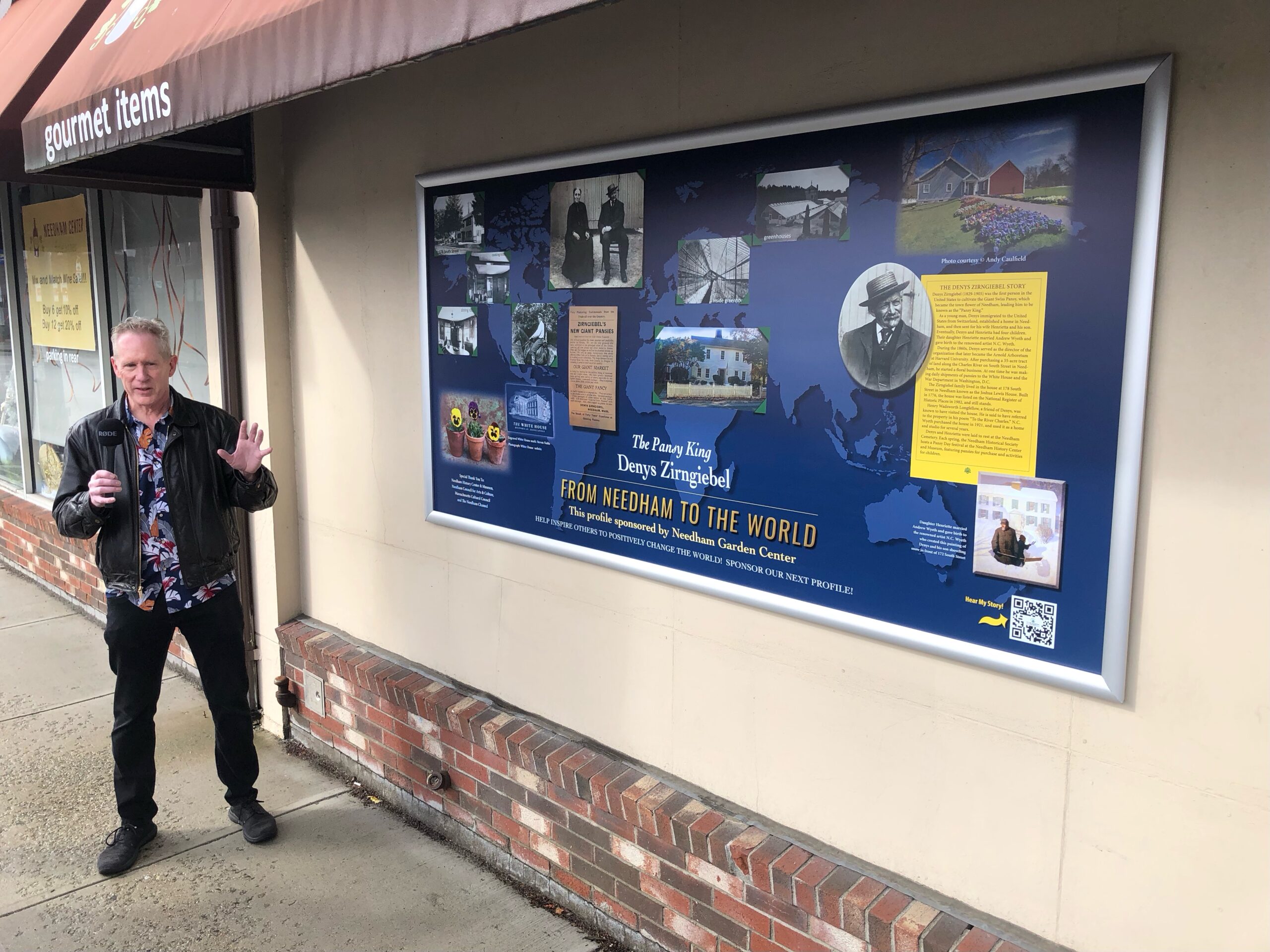
Needham’s ‘Pansy King’ Honored with Mural
March 15, 2024
• Denys Zirngiebel lived an accomplished life in Needham, but many better know his famous family: painters N. C. Wyeth and Andrew Wyeth. A new mural in Needham Center aims to change that.
The Needham Revitalization Trust Fund is paying tribute to Zirngiebel, affectionately called the “pansy king” for his development of the Giant Swiss Pansy. On his more than 30 acres of land in Needham, Zirngiebel cultivated the flower, which he helped to grow in size and popularity.
The four-by-eight-foot mural — located on the side of Needham Center Fine Wines, facing the Town Common — is part of a rotating art project highlighting notable Needham residents. Previous murals featured astronaut Sunita Williams, illustrationist Bob Larson and trumpeter Tiger Okoshi. Zirngiebel’s profile replaces that of Frank Malzone, the former third baseman for the Boston Red Sox, and will be up for four months.
“He built this really impressive business out of nothing,” NRTF’s Jessica Batsevitsky said. “He was an immigrant, and he just started working on this and developed something great.”

The mural displays photographs and a detailed story of Zirngiebel’s life. And for a commercial flower grower, he led an interesting life in town, said Gloria Greis, executive director of the Needham History Center and Museum.
Zirngiebel immigrated from Switzerland after a railroad company took his land for construction, and he ended up in Cambridge working for the Harvard Botanical Gardens. In the 1860s, he bought property on Needham’s South Street, where he created his nursery business that eventually shipped seeds and plants across the country, Greis said. Zirngiebel regularly sent his flowers to the White House and State Department, she said.
His most significant contribution is the pansy, which he developed from the small viola wildflower, also known as the Johnny-jump-up. The flower can typically grow to more than four inches across, as opposed to its much smaller ancestor.
“This was the 19th century, this is when a lot of people were doing hybridization experiments… so he embarked on hybridizing the Johnny-jump-up into what became a large range of different colors,” Greis said.
Growing up, N. C. Wyeth actually worked in his grandfather’s nursery, Greis added.

Over Needham’s more than 300 years, residents have achieved success and acclaim across a diverse set of fields, said NRTF Chair Paul Good. There’s, evidently, many Needhamites to choose from, he said.
“There’s been a lot of people who’ve really done some pretty spectacular things over that course of time,” he said. “These people from Needham have gone off and really changed the world in a lot of positive, interesting ways.”
The mural’s central location and accessibility mean hundreds of passers-by learn the history of previous residents, and the feedback on the project has been “wonderful,” Good said.
Wyeth tends to steal the spotlight, but Zirngeibel’s mural comes at a pivotal time — this spring, Needham will celebrate its annual Pansy Day, where residents can purchase and admire the flower that first bloomed in town. The pansy is also Needham’s official flower, and April is Pansy Month in town.
Zirngeibel’s mark on Needham extends beyond his gardening prowess — he lived in the Joshua Lewis House, which was built in 1776 and still stands. It has recently established as the home of the N. C. Wyeth Foundation.
When Zirngeibel moved there, the town and his neighborhood — Charles River Village — was “very rural,” Greis said, and much of the land was used for farming and cattle grazing.
Sponsors supporting the series earn exposure for their business while also helping to “encourage young people and adults to aspire to do great things, because there’s a bunch of people who lived here who did exactly that,” Good said.
In recognizing local history, current residents can realize Needham’s significance, Greis said.
“It’s not true that you live in a boring town where nothing ever happens. You live in a town where anything could happen,” Greis said. “And I think that’s a lot of what they want to convey with this project.”

